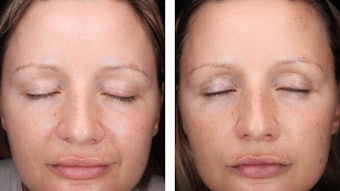
Editor's note: A simple method is described here to measure frizz formation under low-to-high and high-to-low relative humidity. The results are converted to a frizz ratio and correlated with moisture sorption and hair porosity, as will be shown.
Log in to view the full article
Editor's note: A simple method is described here to measure frizz formation under low-to-high and high-to-low relative humidity. The results are converted to a frizz ratio and correlated with moisture sorption and hair porosity, as will be shown.
Human hair is a natural composite system mainly consisting of the sulfur-rich protein keratin. The loosely packed medulla is located at the center, surrounded by cortex. The cortex is composed of microfibrils made of orderly assembled α-helices of amino acids and the intermicrofibrillar matrix. The cortex is covered with cuticular scales made up of proteins and lipids.1 The outermost hydrophobic layer, or F-layer, is tightly joined to the cuticle.
Human hairs are prone to damage caused by various chemical and physical factors.2-5 For example, cleansing with surfactants, bleaching, UV exposure and combinations of thereof are known to leach proteins and lipids from the hair, causing increased porosity.6, 7
Cosmetic treatments can also adversely impact the water retention and absorption properties of hair. A recent study by S. Chikami, et. al., examined the hydration of the hair surface using Fourier Transform Infrared Spectroscopy (FTIR) in combination with multivariate analysis. Results indicated that levels of water were higher in bleached hair than virgin hair, due to the destruction of the hydrophobic layer while bleaching.8 In fact, of all the factors that can damage hair, bleaching causes the greatest leaching of proteins, resulting in more permeability.9
It is well-known that hair has strong covalent bonds and relatively weaker hydrogen bonds. Chemical treatments that permanently reshape hair (e.g., perming or relaxing) act on the covalent disulfide bonds, whereas temporary types of hair setting act on the hydrogen bonds. Hydrogen bonds are highly sensitive to water – and the exchange of water can disturb these bonds, causing hair strands to misalign and leading to the appearance of frizz.
In the literature, frizz is defined as the phenomenon where “the curvature of the neighboring hairs of an assembly are not synchronized (parallel), producing the appearance of disorder or disarray.”10 Frizz control is an essential beauty consumer demand. The market for frizz control shampoo alone was projected to expand at a 7.1% CAGR from 2024-2031, although various anti-frizz product types are available.11 This growth is likely to continue, especially considering the increase in relative humidity tied to climate change.12
Hair’s condition before and after treatment with frizz control products is visibly recognizable. As such, commonly used methods to measure frizz involve visually inspecting hair swatches and numerically scoring treated hair versus the untreated control.
Instrumental methods also are used. For example, 2D laser-based images of hair swatches can be recorded and analyzed using software to determine jaggedness and calculate frizz. McMullen, et al., even quantified frizz using three-dimensional plots of hair obtained by laser stereometry.13
Specialized instruments such as these, however, can be expensive and are often not accessible to the general populace. And to perform the image analysis, analysts must be trained and software parameters must be configured – which can introduce variability into the results.
To circumvent these constraints, the current work describes a user-friendly and cost-effective method to measure hair frizz and calculate a hair frizz ratio, as will be shown. Frizz formation relative to moisture sorption – including measurements from both low to high, and high to low humidity – and correlations with porosity properties are also introduced that provide a deeper understanding of the mechanisms behind hair frizz formation.
RH Study Approach: A Proposal
Generally, to check the extent of frizz, hairs are styled at a lower relative humidity (RH) (~30%) and then moved to a higher humidity (~80%). The expansion of the hair swatch with increased humidity is then determined as an indicator of frizz.13, 14
However, hair dealignment also occurs when wet hairs dry at a relatively low humidity. And consumers are more likely face the high-to-low RH condition as they wash their hair, then dry it – a common grooming practice.
Hence, in this study, the generation of frizz from low to high as well as high to low RH conditions for virgin and bleached hairs is measured.
Materials and Methods
Hair sample preparation: Virgin hair samples were obtaineda for the described tests. Tresses were ~20 cm long, of Indian origin and naturally black in color. Bulk hair was divided into 5 g swatches. Once received, each swatch was washed once with 0.5 mL of 15% sodium laureth sulfate (SLES) solution, dried and stored at 65% RH and 25°C. The swatches were then divided into five groups for different treatments and humidity exposures, described next.
Hair groups and treatment conditions: As stated, the hair was divided into five groups (n = 10 swatches each): virgin hair (VH) and bleached hair (BH) served as baselines, and serum-treated bleached hair (BHS), conditioner-treated bleached hair (BHC) and coconut hair oil-treated hair (BHO) were examined for the effects of frizz reduction treatments.
For the various tests, these groups were further divided (n = 5 swatches each) for two RH conditions: low-to-high RH (LHR) and high-to-low RH (HLR); Figure 1 visualizes these treatments and the procedure for each.
Bleaching treatment: Swatches were bleached using commercial products containing standard components like hydrogen peroxide, ammonium persulfate, sodium persulfate and EDTA. The bleaching paste was prepared per the manufacturer’s instructions and applied to hair for 30 min. Bleaching was followed by washing with a 15% SLES solution. This cycle of bleaching was repeated twice and the samples obtained were used for further analysis.
Serum, conditioner and hair oil treatments: The hair serum used for the described tests was obtained commercially and contained cyclopentasiloxane, dimethicone and dimethiconal gum as key ingredients. A commercially available hair conditioner and coconut-based hair oil also were obtained for this study.
Frizz Generation
As noted, the generation of frizz was measured under two different RH conditions: LHR and HLR.
Low to high (LHR): For the LHR group, swatches were styled with a heat-straightening device at 190°C for 3 min to decrease the moisture content in hair. Styling was performed at low humidity (40% RH), then hair swatches were exposed to a higher RH (85% RH).
The test hair serum was applied post-washing and after styling with the heat straighter. The conditioner was applied post-SLES wash, rinsed off, then hair was styled with the heat straighter.
In the case of hair oil, oiling cycles were carried out as shown in Figure 1 – i.e., bleached hair was washed, 0.5 mL of oil was applied to hair, then the oil was left in hair overnight. This cycle was repeated three times. Following the final wash, hair was styled with the heat straightener.
The change in frizz on the hair swatches was captured using a digital camera and at time intervals of T0, at 1 hr and 2 hr. All images were taken using the same camera settings.
High to low (HLR): For the HLR group, bleached untreated hair swatches were washed with water and SLES, towel dried, combed five times, then allowed to dry at 40% RH. This process was adapted based on the given treatment: for serum-treated hair, after washing, serum was applied; for conditioner-treated hair, the SLES wash was followed by the conditioner; and for the oil treatment, after the three-day cycle previously described, hair was washed with SLES. For all three treatments, hair was then towel dried, combed and left to dry at 40% RH.
Changes in frizz for the hair swatches were captured initially and at time intervals of 1 hr and 2 hr using a digital camera.
Measuring Frizz Ratio
The captured images were analyzedb by opening them and defining the pixel distance (in cm) with the help of a premeasured line that was drawn while capturing the image. The maximum length of the hair swatch (Lmax), from the tip to the bottom, and the maximum width of the hair swatch (Wmax) were measured as shown in Figure 2.
The frizz ratio of the hair swatch was then calculated with following formula:
Frizz ratio = Lmax
Wmax
The higher the frizz ratio, the lower the frizz and vice-versa. Alternately, a simple measurement scale starting at 1 mm (~ 0.04 inches) could be used to measure the Lmax and Wmax.
Moisture Measurements
In relation to frizz measurements, as noted, mechanisms of frizz formation were examined. Water sorption, for example, was analyzed by gravimetry using a highly accurate analytical balancec (to 0.0001 g). Sealed bottles were used for weighing.
The initial weight of hair was recorded for both LHR and HLR conditions, then hair was exposed to respective humidities. Humidity was maintained in a humidity- and temperature-controlled chamber and was continuously monitoredd. Weight was recorded initially (T = 0), at 1 hr and 2 hr to measure and monitor differences in moisture content.
BET Porosity Measurements
In addition, hair porosity was measured using the Brunauer-Emmett-Teller (BET) method. This technique determines the specific surface area of a sample through the physical adsorption of a gas on its surface. Typically conducted at the temperature of liquid nitrogen, the amount of gas adsorbed is quantified, which is then used to calculate the surface area based on adsorption measurements.15
Samples were cut into fine segments 1-cm across the length of hair strands, then mixed homogeneously to ensure uniform sampling. From the mix, 0.5 g hair segments were taken and placed in a sample cell under vacuum at 145°C for 30 min. This elevated temperature was used to facilitate the complete removal of water and to obtain accurate measurements. It was based on a study of differential scanning calorimetry (DSC), in which a dehydration peak appears at ~125°C.7
Five-point BET surface area analysis was performede for all hair samples and the total pore volume was collected at a P/Po (i.e., relative pressure) of 0.995, representing 99.5% of the saturation pressure.
Results: Generation of Frizz
It is well-known that hair becomes frizzy when it is subjected to higher humidities.10 In this study, as described, sets of virgin and bleached hair were styled with a heat straightener at a lower RH of 40%, then subjected to a higher RH of 80-90%. As expected, this exposure to higher RH showed a reversal of styling, which aligns with other studies reported in the literature.
A visual comparison of the frizz generated in virgin vs. bleached hair showed significant differences within 2 hr of exposure to high humidity (see LHR of virgin and bleached hair shown in Figure 3). Also, bleached hair had more frizz than virgin hair.
In addition, when wet hair is exposed to a very dry environment immediately (30-40% RH), the dealignment of hair strands takes place, causing a frizzy appearance. Interestingly, under this condition as well, bleached hair had more frizz than virgin hair (see also Figure 3).
Results: Frizz Ratio Measurements
Simple frizz ratio measurements were made as described in the previous section. The value of the frizz ratio (length/width) ranged from 9 to 2; where the lower the ratio, the higher the frizz. Only the virgin and bleached hair groups were used for this test, with 5 swatches of each under LHR and HLR conditions; the standard error obtained was low for all conditions and at all time points (see Figure 4).
The visual differences described in the frizz results section above were also reflected in the frizz ratio (see Figure 2 and Figure 3). This method was therefore used further to evaluate the effect of serum, conditioner and oil on frizz, described later.
Results: Moisture Measurements in Virgin and Bleached Hair
Virgin and bleached hair swatches subjected to LHR and HLR conditions were then measured for moisture content by gravimetry. Swatches were monitored for moisture content at T0, at 1 hr and 2 hr. The difference in moisture sorption for both conditions is shown in Figure 5.
The data shows that the hydrophilic nature of the hair strands remained consistent under all conditions. As the humidity increases, the water content in hair increases, leading to swollen fibers. Notably, the moisture absorption of bleached hair was higher than virgin hair, which could be due to the higher hydrophilicity of bleached hair.
On the contrary, when bleached hairs were exposed to HLR conditions, a higher amount of water desorption was observed, as compared to virgin hair. Both observations denote that the rate of sorption of bleached hair is higher than that of virgin hair. Considering the higher sorption as well as frizz generation in bleached hair, the effect of treatments including serum, conditioner and a coconut-based hair oil were evaluated in bleached hair, described next.
Effects of Hair Treatments on Moisture Content and Frizz Ratio
To understand the aforementioned treatments on frizz, their impact on moisture absorption or loss were evaluated in bleached hair. Products were applied as described previously and after application, swatches were exposed to HLR and LHR conditions.
The extent to which moisture changed was measured after 1 hr and 2 hr. Changes in the moisture content and frizz ratio in serum-treated bleached hair (BHS), conditioner-treated bleached hair (BHC) and coconut hair oil-treated bleached hair (BHO) are compared with bleached-only hair (BH) in Figure 6 and Figure 7, respectively.
Under low to high RH conditions (LHR), all three cosmetic treatments showed significantly lower water absorption than the bleached-only hair (see Figure 6, top). Among the three treatments, the serum showed a higher rate of moisture loss compared with the conditioner and oil.
In case of high to low RH conditions (HLR), all hair groups tended to lose moisture over the two hours. However, there was an interesting difference in the rate of moisture loss. Bleached-only hair lost significant amounts of moisture within 1 hr, almost reaching an equilibrium state. Bleached hair with the various treatments showed different amounts of moisture absorption (see Figure 6, bottom).
The frizz ratios also changed with the various hair treatments. All showed increases vs. the bleached-only hair under both LHR and HLR conditions – and the higher the frizz ratio, the lower the frizz. Hair treated with the serum showed the highest frizz ratio, followed by the conditioner, then the oil.
Discussion: Moisture and Frizz
Under LHR conditions, hair styled with a heat straightener at a lower RH of 40% was exposed to higher humidity at 90% RH to mimic low to high humidity conditions. This reversed the straightening treatment. This effect can be explained by hydrogen bonds.16
During the heat styling process, the hydrogen bonds contributing to the secondary structure of the hair protein are temporarily disrupted. At this stage, hair becomes malleable and can be molded into the newly desired form since temporarily broken hydrogen bonds re-bond themselves at new positions, setting the hair into a new shape.
However, when styled hair is exposed to higher humidity (90%), it absorbs water from the surrounding environment. This influx of water disturbs the newly formed hydrogen bonds and hair returns to its natural state. This explains the effect of water absorption on the overall structure and appearance of styled hair. The correlation of frizz with water content of hair is given in Figure 8.
In comparison with virgin hair, bleached hair developed more frizz. This is because treatments like bleach degrade the hydrophobic layer of hair, increasing its hydrophilicity and altering the rate of moisture absorption so that it is significantly higher than that of virgin hair. Therefore, bleached hair tends to absorb more water, resulting in higher frizz generation. This observation is in line with a previously reported study.17
However, when towel-dried, combed hair swatches at a higher 90% RH were exposed to a lower 30-40% RH, the dealignment of strands was also observed, causing frizz. And despite having a hydrophilic surface, bleached hair showed faster water loss than virgin hair (see Figure 6, bottom). This can be explained by the increased porosity of bleached hair.
Results: BET Porosity Measurements
The preliminary BET porosity measurements of virgin and bleached hair indicated the bleached hair had a significantly higher surface area and total pore volume than virgin hair (see Table 1). These results are in line with studies conducted by Hessefort.7 Thus, hydrophilicity and porosity both affect the moisture sorption of hair, impacting the frizz.
Discussion: Anti-frizz Product Dynamics
When hydrophilic and porous bleached hairs are treated with hair care products like serum, conditioner and oil, the moisture sorption decreases, along with frizz. However, the change in water sorption and extent of the anti-frizz benefits of these products are different from one another, as are their mechanisms.
Hair serum: The serum used in the described tests is a combination of low molecular weight volatile silicones (e.g., cyclopentasiloxane) as well as high molecular weight silicone-based gums (e.g., dimethicone). As a leave-on product, it is applied to hair, after which it begins to lose volatile silicones as the non-volatile gums deposit as a thin hydrophobic layer on the hair shaft. This prevents moisture from penetrating inside the most effectively: the protective layer seals off the surface pores, significantly restricting moisture sorption and giving the best anti-frizz benefits.
Hair conditioner: Unlike serum, hair conditioner is a wash off product. However, the actives in conditioner, like quaternary ammonium salts, cationic polymers and silicones, are deposited onto hair. These actives are hydrophobic in nature and therefore resist moisture sorption.
Hair oil: In contrast to serum and conditioner, after the oiling cycle, the coconut-based hair oil is washed off of the surface of hair – still, it was shown to decrease water sorption. This can be explained by the proven phenomenon of mid chain triglyceride-rich coconut oil penetrating into the hair shaft.
Various studies based on radiolabeling and TOF-SIMS techniques have demonstrated this effect.18 The effect of coconut oil on damaged porous hair has also been studied by BET analysis.6 Previous research also has shown that even after washing, coconut-based hair oil penetrates inside the hair shaft and remains inside the pores formed due to damage.18, 19 The penetrated oil might therefore be filling the pores of bleached hair, slowing water sorption and therefore reducing frizz.
Conclusion
The method proposed here to measure hair frizz is simple yet effective. The novelty of the approach is its consideration of both low-to-high and high-to-low measurements, both of which support the calculation of a frizz ratio, and the correlation of this frizz ratio with not only hair moisture content, but also hair porosity measurements.
The porosity study confirmed that bleaching of hair increases porosity – and highly porous and oxidized hair has high sensitivity to changes in relative humidity. The rate of water absorption or desorption is also higher in hair with higher porosity and water sorption drives the rearrangement of hydrogen bonds in hair, which causes dealignment of hair fiber assembly. This dealignment of hair fiber assembly appears as frizz.
Finally, to address frizz, treatments such as hair oil, conditioner or serum can be effective and they offer different possible modes of action. Serum can form a thin hydrophobic layer on the hair surface, reducing moisture sorption. Similarly, conditioner can deposit a film on hair thanks to the interaction of cationic components of conditioner with hair, which creates a hydrophobic barrier against water sorption. Lastly, coconut-based hair oil has been shown to penetrate the hair strand, which could alter its porosity and therefore moisture interactions with hair.
Footnotes
a Raj International, Chennai, India
b ImageJ open source software, version 1.54d
c Mettler-Toledo, Model MS204S/A01
d Humidity meter, Zeal, BSI registered
e Quantachrome Autosorb-lC
References
1. Robbins, C.R. (2002). Chemical and Physical Behavior of Human Hair. Springer eBook Collection, New York.
2. Cao, Y., Hao, Q., Xiong, C., Liu, C. and Zheng, L. (2017) A novel method for non-destructive determination of hair photo-induced damage based on multispectral imaging technology. Scientific Reports, 7 45544; doi: 10.1038/srep45544; available at https://www.nature.com/articles/srep45544
3. Lima, C.R.R.D.C., Couto, R.A.A.D., … Freire, T.B., et al. (2019). Heat‐damaged evaluation of virgin hair. J Cosmet Dermatol, 00:1-8.
4. Qu, X. Niu, L. and Foltis, L. (2018). Pollution damage and protection of Asian hair. Cosmetics, 5 17; https://doi.org/10.3390/cosmetics5010017
5. Aparecida, S. and Ferrera, M. (2015). Protein loss in human hair from combination straightening and coloring treatments. J Cosmet Dermatol, 14 204-208.
6. Kaushik, V. and Gosvami, N. (2022). Benefit of coconut–based hair oil via hair porosity quantification. Int J Cosmet Sci, 44(3) 289-298.
7. Hessefort, Y. and Holland, B. (2008). True porosity measurement of hair: A new way to study hair damage mechanism. J Cosmet Sci, 59 303-315.
8. Chikami, S. (2024). Analysis of the hydration water on the surface of human hair using a combination of infrared absorption vibrational spectroscopy and multivariate curve resolution. Surf Interface Anal, 1-7.
9. Barba, C. and Martí, M. (2010). Water absorption/desorption of human hair and nails. Thermochimica Acta, pp 33-39.
10. Evans, T.A. (2015, Apr 22). Defining and controlling frizz. Cosm & Toil. Available at https://www.cosmeticsandtoiletries.com/testing/efficacy/article/21835330/defining-and-controlling-frizz
11. Persistence Market Research. (2025, Jul 29). Global frizz control shampoo market to grow at 7.1% CAGR, surpassing USD 4.7 billion by 2031. Open PR. Available at https://www.openpr.com/news/4123982/global-frizz-control-shampoo-market-to-grow-at-7-1-cagr#
12. Barreca, A.I. (2011 Sep). Climate change, humidity and mortality in the United States. J Environ Econ Manage. Available at https://pmc.ncbi.nlm.nih.gov/articles/PMC4199665/
13. McMullen, R. (2012). Image analysis tools to quantify visual properties of hair fiber assemblies. ISP, 9.
14. Brandt, M. and Springmann, G. (2017). Substantiating claims for hair care products and personal care. Sofw J 142.
15. Rabia, I., Badrul, M.J. and Waqas, A. (2020, Sep/Oct). An overview of industrial scalable production of graphene oxide and analytical approaches for synthesis and characterization. J Mat Res and Tech. Available at https://tinyurl.com/yhzhcsru
16. Zhou, Y. and Rigoletto, R. (2011, Mar/Apr). The effect of various cosmetic pretreatments on protecting hair from thermal damage by hot flat ironing. J Cosmet Sci, 62 265-282.
17. Gao, T. (2007). Evaluation of hair humidity resistance/moisturization from hair elasticity. J Cosmet Sci, 58 938-404.
18. Gode, V. and Bhalla, N. (2012). Quantitative measurement of the penetration of coconut oil into human hair using radiolabeled coconut oil. J Cosmet Sci, 63 27-31.
19. Ruetsch, S.B. and Kamath, Y.K. (2001). Secondary ion mass spectroscopy investigation of penetration of coconut and mineral oils into human hair fibers: Relevance to hair damage. J Cosmet Sci, 52, 169-184.










